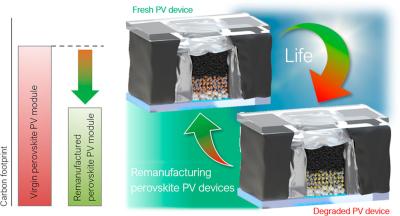Researchers introduce a new lead-halide-based Ruddlesden–Popper perovskite structure
Researchers from EPFL, University of Bern and HZB have introduced a new lead-halide-based Ruddlesden–Popper perovskite structure based on a visible-light-absorbing naphthalene-iminoimide cation. The team stated that the optoelectronic properties of this new material represent an important step toward enhancing light harvesting and affording the spatial separation of charge carrier transport in stable layered perovskite-based devices.
Incorporating organic semiconductor building blocks as spacer cations into layered hybrid perovskites provides an opportunity to develop new materials with novel optoelectronic properties, including nanoheterojunctions that afford spatial separation of electron and hole transport. However, identifying organics with suitable structure and electronic energy levels to selectively absorb visible light has been a challenge in the field. In their recent paper, the team introduced a new lead-halide-based Ruddlesden–Popper perovskite structure based on a visible-light-absorbing naphthalene-iminoimide cation (NDI-DAE).




